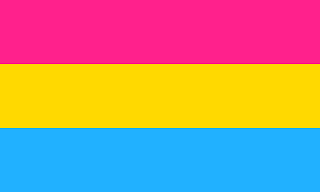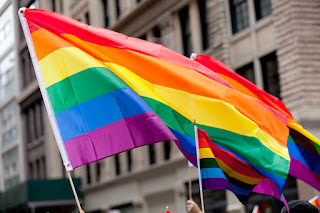Pansexuality: A Many-Layered Exploration
1685 Words
Why is it that when a person is asked which part of their identity is most salient to them, there is usually an easy answer? For me, the idea of sexuality sprung to mind and I quickly realized that we are bound to notice most our identity which is hardest for us to fit into, and therefore causes us the most social strife. If scripts (Wideman, 183), or specific stereotypes, and societal norms didn’t exist, then identity would be easy. We would simply float between feelings, expressing our most core selves without judgment. Instead, we are left fighting assumptions about our very being and with the burden of proving that we fit in (or don’t) all of the time. This paper will argue that my identity as queer woman is shaped by the intersectional societal norms associated with gender, sexuality, and race. It will draw from essays by Gloria Anzaldúa and Judith Lorber and have a heavy focus on the areas of physical presentation and internal sense of community.
While writing with different focuses, Anzaldúa and Lorber both explore a topic that is central to what I seek to put into words about myself: how societal norms about behavior and presentation are truly just rules put into place by people in power and have nothing to do with how I self-identify. In the essay “Night to His Day: The Social Construction of Gender,” Lorber quotes a trans woman who recalls changing her behavior based on those around her.
The more I was treated as a woman, the more woman I became. [...] If I was assumed to be incompetent at reversing cars, or opening bottles, oddly incompetent I found myself becoming. If a case was thought too heavy for me, inexplicably I found it so myself... I discovered that even now men prefer women to be less informed, less able, less talkative, and certainly Less self-centered than they are themselves; so I generally obliged them[citations omitted] (Lorber, 59).
This quote exemplifies societal norms at work perfectly. Even as someone who grew up untethered to female scripts, Jan Morris adopted completely arbitrary characteristics associated with femininity to pass, especially around her male counterparts. While Lorber’s article focuses on gender, its ideas can be applied to the norms set for people based on sexuality as well. Why did I feel so much pressure to look and act like Barbie growing up, with pretty dresses and bows, and why did such pressure make me feel so viscerally wrong? The societal gender norms set in place for women are intrinsically tied to sexuality, as they are constructed under the “male gaze” (Mulvey, 808) or with the intention of pleasing straight men and putting them in positions of power over women. I felt an innate need to exist outside of these norms, in a rejection of this compulsory heterosexuality, without knowing quite why at the time. As I discovered my queerness, I also discovered a new set of norms and followed them blindly, not quite myself, but definitely more comfortable than before. I think of these norms as existing under the queer gaze, or even just the female gaze. While they don’t always predict queerness in women, more traditionally masculine mannerisms or ways of dressing are often seen by society as a signal of lesbianism, as they are not usually attractive to the “male gaze.” As I was just discovering my sexuality and hoping to fit in with other people in the LGBTQ+ community, my mannerisms, sense of style, and overall expression were heavily shaped by the societal norms associated with being queer.
https://wwd.com/fashion-news/fashion-scoops/barbie-doll-industry-barbiecore-fashion-euromonitor-1235744029/Building off of the male gaze and the subjugation of women, laws throughout history have enforced the idea that women must change their behavior and aspects of their identity based on men. In her essay about marriage equality through the years, Eloise Fairbrother describes the complex laws around marriage of American women to men who are not citizens of the United States, and the societal context that comes with that. “The act of forcing a woman’s citizenship and cultural identity to align with her husband’s not only eliminates her sense of individuality and belonging to a country, but also signifies a feeling of betrayal from the country.” (Fairbrother) Even in the complex state of citizenship and the law, women have been expected to conform to a patriarchal society, and forced to give up aspects of their identity. Laws like the Naturalization act of 1907 were by no means the beginning of the patriarchal pressures felt by women today, but they serve as telling evidence that the structure of patriarchy has been built so concretely into society for years that laws enforcing it were deemed acceptable.
As a white woman, my sexuality does not exist in a vacuum devoid of my other identities. This paragraph will explore how my white, Christian background intersects with my queer identity and the norms that come along with it. Intersectionality is the belief that one’s many backgrounds can never be truly separated, and that the oppression or privilege experienced because of one aspect of identity is intrinsically linked to all other aspects. (Hankivsky, 2) In white American society, the binary differences between “femininity” and “masculinity” are concepts that are imbued and enforced from birth with no exceptions. Lorber delves into how other cultures simply do not view gender as the rigid thing that we do in the US. “Western societies have only two genders[…] Some societies have three genders-men, women, and berdaches or hiiras or xaniths. [These] are biological males who behave, dress, work, and are treated in most respects as social women; they are therefore not men, nor are they female women; they are, in our language, ‘male women.’” [citations omitted](Lorber, 57). Simply by describing the diversity of gender outside the US, this quote supports my idea that my struggle between gender and sexual binaries is tied to my whiteness. The prevalence of Christianity in Western society also plays into this, as Christianity upholds specific norms that were not created by accident. In order to justify the teachings of modesty, purity, and submissiveness to women, the binary has to be enforced early. This is exemplified in the dress codes at Catholic schools like Lancaster Catholic High School, which recommends skirts for women, but specifies their length to ensure “Catholic modesty.” The intersections of my identity further explain why I felt pushed into such rigid gender roles and had to discover more authentic ways of expressing myself.
https://www.lchsyes.org/apps/pages/studentWhen I first realized I wasn’t straight, I hoped I was at the beginning of my journey to realizing I was a lesbian. Although I knew the queer community was generally very welcoming, the realization that my sexuality was actually more of a hybrid of “gay” and “straight” created a whole new fear of never quite fitting in. I was, and still am, dealing with the phenomenon of having to “ride the hyphen'' of identity (Buckmire, 9/20/2023), or walk the line between two communities with distinct and opposing cultural attitudes. While I immediately clicked more with my queer friends in high school than I had with people in my majority straight Catholic school, there was still a fine current of biphobia that I felt that caused feelings of alienation from both communities. Sadly, being bisexual, much like being biracial, still has connotations of being a lesser version of both of the “halves.” In “La Conciencia de la Mestiza,” Anzaldúa describes the myths surrounding hybridity of two identities, and proves them wrong. “Opposite of the theory of the pure Aryan, [...] his theory is one of inclusivity. At the confluence of two or more genetic streams, with chromosomes constantly “crossing over,” this mixture of races, rather than resulting in an inferior being, provides hybrid progeny, a mutable, more malleable species with a rich gene pool” (Anzaldúa, 377). While acceptance for bisexuals has been steadily growing, much like the idea of the new mestiza race being its own valid category, there still exists a lack of true community. I find myself changing my behavior depending on the sexualities of those around me, and often not letting my true self show. Hybridity means a true mix between two distinct groups, the state of being two things at once. Bisexuality truly is a hybrid identity, a balancing act between cultures and their distinct sets of norms.
https://brainly.ph/question/20082814So what could it mean to exist beyond the binary; to jump off of the metaphorical fence and find a new plot of land? When exploring my identity as a queer woman through analyzing how my physical presentation and internal sense of community is shaped by societal norms, I have discovered that the structures of binary opposition such as the male and female gaze fall short in fully encompassing my true sense of sexual identity. Pansexuality means attraction to people regardless of their gender, and often based on characteristics outside of gender. (Firestone) While the pansexual community is not a large one, the fact that other people exist outside of the binary when it comes to attraction is deeply validating and freeing. I’ve grown to like a few dresses now. I am open about the fact that I’ve dated women and men, because I know now that no one can take my queerness from me. Though societal norms still influence how I present myself, I’m trying to remember that they don’t dictate who I am, and I can leave them in the dust whenever I want. In this way, using a pansexual framework to understand my identity outside of the more strict lenses created by the male and female gazes, or the binaries of attraction to men, women or both leads to more of a sense of belonging, and a better understanding of myself.
In conclusion, my pansexual identity has been shaped immensely by the societal norms constructed by my race, gender, and sexuality, but often exists outside their binaries because of its nature as a nonbinary identity. Through exploration of different perspectives and viewpoints, I am trying to deconstruct harmful scripts and exist as the truest form of myself.
Works Cited
Anzaldúa, Gloria. Borderlands/La Frontera: The New Mestiza. San Francisco, Aunt Lute Books, 1987.
Fairbrother, Eloise. The Watchful White Eye. 2023
Firestone, Shulamith. The Dialectic of Sex: The Case for Feminist Revolution. 1970. London ; New York, Verso, 2015.
Hankivsky, Olena. INTERSECTIONALITY 101. 2014.
Lorber, Judith. Paradoxes of Gender. Yale University Press, 1994, p. Chapter 1.
McManaman, Daisy. “Hyper-Femininity Can Be Subversive and Empowering – Just Ask Barbie.” The Conversation, 20 July 2023, theconversation.com/hyper-femininity-can-be-subversive-and-empowering-just-ask-barbie-209623#:~:text=Some%20feminists%20argue%20that%20Barbie%27s. Accessed 6 Oct. 2023.
Mulvey, Laura. Visual Pleasure and Narrative Cinema. London Afterall Books, 1 Oct. 1975.
“Student Uniforms.” Www.lchsyes.org, www.lchsyes.org/apps/pages/index.jsp?uREC_ID=688384&type=d&pREC_ID=1133402. Accessed 6 Oct. 2023.
Susan Richards Shreve, and Porter Shreve. Outside the Law. Beacon Press, 1997.





Can you change the font color to white so the text is more legible? :)
ReplyDelete